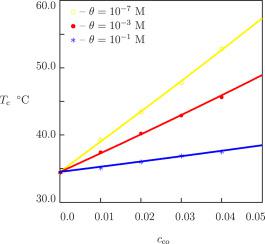International Journal of Mechanical Sciences ( IF 7.1 ) Pub Date : 2021-08-27 , DOI: 10.1016/j.ijmecsci.2021.106753 Aleksey D. Drozdov 1 , Jesper deClaville Christiansen 1

|
Thermo-responsive (TR) hydrogels of the LCST (low critical solution temperature) type swell noticeably below their volume phase transition temperature and collapse above . Biomedical applications of these gels (in particular, for controlled delivery of nuclear acids and genes) require fine tuning of the critical temperature. Modulation of is conventionally performed by copolymerization of TR monomers with monomers whose hydrophilicity is higher or lower than that of the main monomers. The most pronounced changes in are observed when TR monomers are copolymerized with anionic or cationic monomers. Introduction of polyelectrolyte monomers into the polymer network induces a strong dependence of its properties on pH and ionic strength of an aqueous solution. A constitutive model is developed to describe the effects of pH and molar fraction of salt in a solution on the critical temperature of TR polyelectrolyte hydrogels. Adjustable parameters are found by fitting equilibrium swelling diagrams on copolymer gels with strongly and weakly dissociating cationic functional groups. The ability of the model to predict is confirmed by comparison of experimental data with results of simulation.
中文翻译:

调节多刺激响应共聚物水凝胶的体积相变温度
LCST(低临界溶解温度)型热响应 (TR) 水凝胶在其体积相变温度以下显着膨胀 然后倒在上面 . 这些凝胶的生物医学应用(特别是用于控制传递核酸和基因)需要对临界温度进行微调。调制通常通过TR单体与亲水性高于或低于主要单体的单体的共聚来进行。最明显的变化当 TR 单体与阴离子或阳离子单体共聚时观察到。将聚电解质单体引入聚合物网络会导致其性质强烈依赖于水溶液的 pH 值和离子强度。开发了一个本构模型来描述 pH 值和溶液中盐的摩尔分数对 TR 聚电解质水凝胶的临界温度的影响。通过在具有强离解和弱离解阳离子官能团的共聚物凝胶上拟合平衡溶胀图,可以找到可调参数。模型预测能力 通过将实验数据与模拟结果进行比较来证实。









































 京公网安备 11010802027423号
京公网安备 11010802027423号